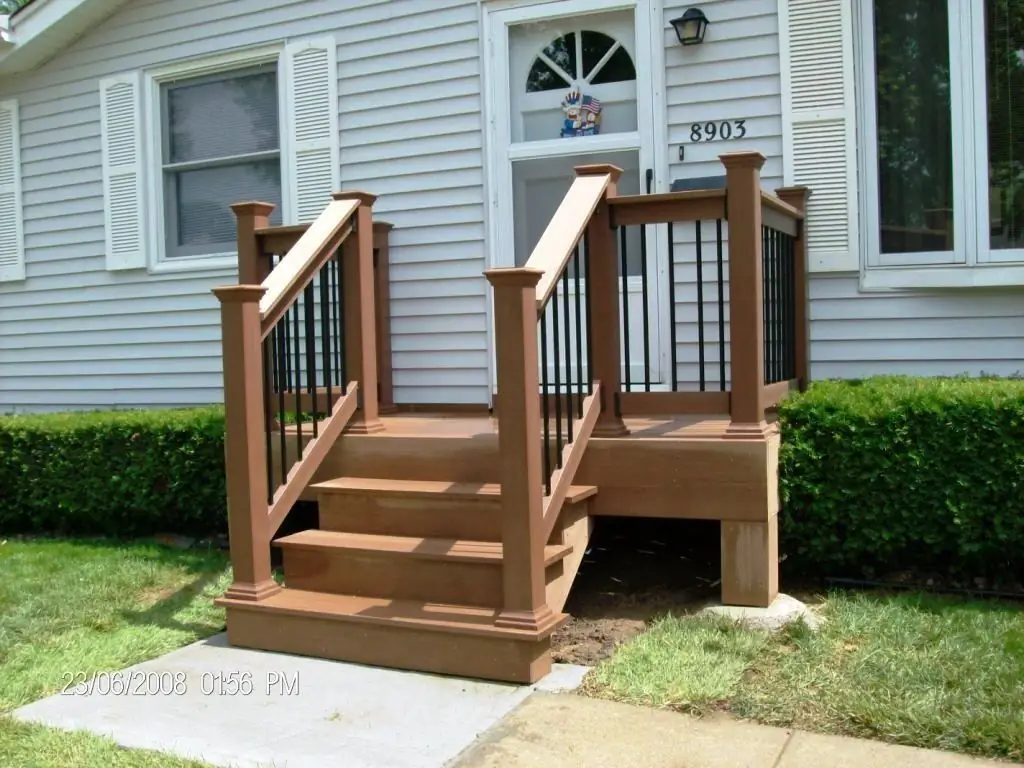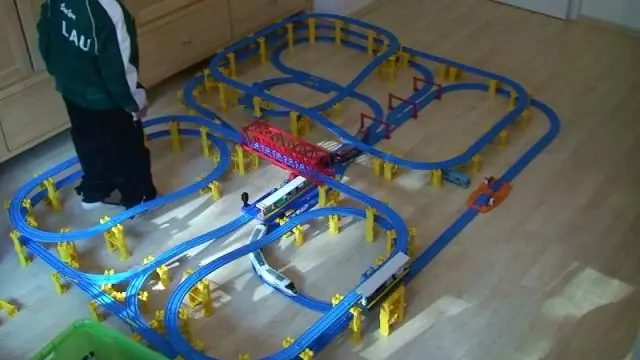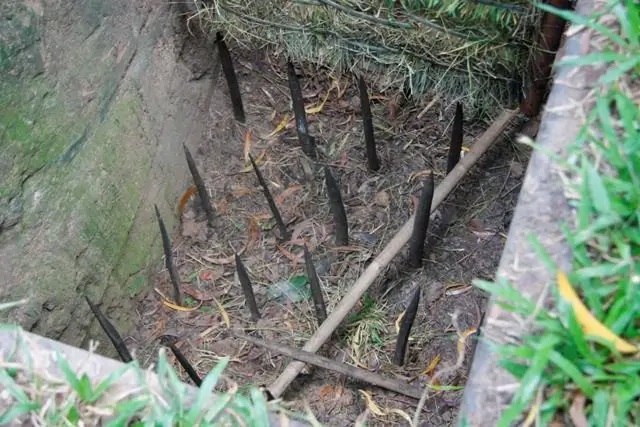
Table of contents:
- Author Bailey Albertson [email protected].
- Public 2024-01-17 22:26.
- Last modified 2025-06-01 07:32.
DIY polycarbonate greenhouse

Every owner of a summer cottage or country house who grows flowers or vegetables strives to protect the plants from early frosts and get a good harvest in the future. For these purposes, it is best to build a greenhouse or mini greenhouse using polycarbonate. This modern material will last a long time. And if you develop and implement a project with your own hands, you can get tangible savings.
Content
- 1 Advantages of polycarbonate in the manufacture of a greenhouse
-
2 Greenhouse device
2.1 Photo gallery: different types of structures
-
3 Preliminary preparation: drawings, diagrams, dimensions
- 3.1 Choice of material for the frame
- 3.2 Which polycarbonate to choose
- 4 Calculation of materials, required tools
-
5 How to make a polycarbonate greenhouse with your own hands: step by step instructions
- 5.1 Preparing the foundation
- 5.2 Assembling the frame
- 5.3 Wall cladding with polycarbonate
- 5.4 Installing the door and vents
- 5.5 Video: how to make a polycarbonate greenhouse with your own hands
Advantages of polycarbonate in the manufacture of a greenhouse
Polycarbonate is a modern and durable material that has replaced the usual plastic film and glass. They are still used in the manufacture of greenhouses, but the plastic film breaks easily under gusts of wind, and the glass is fragile and cracks under mechanical stress.

The film may be torn off or damaged in strong winds and will require replacement
A polycarbonate greenhouse can be purchased prefabricated, standard sizes, or developed and built according to your own drawings, since the Internet offers schemes of various designs. The latter option is more profitable, since you can select materials at your own discretion and at an attractive price.

A drawing of a standard greenhouse can be found on the Internet and altered to fit your size
Polycarbonate has several advantages:
- withstands large temperature differences;
- does not require annual replacement;
- service life is several years;
- resistant to mechanical damage;
- lightweight and easy to install;
- can take a curved shape;
- has a high light transmission (90%) and remains transparent for a long time;
- affordable price.
Of the shortcomings of a polycarbonate greenhouse, one can note the high windage of the structure, which will require the creation of a reliable and fixed support. It is necessary to observe accuracy when attaching polycarbonate to the frame so that the sheets do not sag and the geometry of the structure is not disturbed - this may lead to failure. In hot weather, ventilation is necessary.
Greenhouse device
Confusion between greenhouse and greenhouse should be avoided. Outwardly, they are similar, but still have a number of differences. First of all, the greenhouse is smaller than the greenhouse. But the main difference is how it works. The greenhouse is self-sufficient in keeping heat, since energy is generated by the greenhouse effect created by the sun and the heat generated by the decomposition of organic matter. The greenhouse is used only from early spring to autumn frosts.

The greenhouses have an irrigation system and an additional heating source
In the greenhouse, the greenhouse effect is created by an external source of heat - electricity, fuel oil, gas, and the harvest can be obtained throughout the year.
Greenhouses by type of installation are divided into aboveground and in-depth
In deep greenhouses, thermal insulation is higher due to the thickness of the soil. For its construction, a trench is dug, along the perimeter of which a strapping is made of logs or a row of brickwork is made, and then an external frame is attached. It is called the "Russian greenhouse".

Biomass releases heat, which acts as a "stove" for the greenhouse
Above ground greenhouses are otherwise called French. They are lightweight structures that are easy enough to assemble and disassemble and can be installed during the season. The disadvantage of this type of greenhouse is a lower energy saving rate, since they have a large surface for cooling. But the temperature, which can not be kept quite enough in order to grow early crops or prevent the seedlings from freezing.

Polycarbonate construction with hemispherical roof
Above ground greenhouses can have different types of roofs and hatches for ventilation - "butterfly", "snail", "Belgian", "dragonfly", "convertible". The most common option is a gable roof. A pitched roof can be damaged by snow if the greenhouse is left unassembled for the winter. For the convenience of caring for plants, it is better to equip a high greenhouse with a door, for a low greenhouse, a door is optional.
Photo gallery: various types of structures
-

Land greenhouse butterfly - One side can be opened to ventilate the greenhouse
-

Mini greenhouse with retractable roof - The snail roof will allow you to care for plants
-

Greenhouse with a pitched roof - You can use stops to ventilate the greenhouse
-

Belgian greenhouse - A gable roof will allow you to open each side individually
-

Greenhouse with a metal frame - The greenhouse is equipped with a door and hatches for ventilation
-

Greenhouse with a hemispherical roof - There is a ventilation window above the front door
-

Polycarbonate greenhouse with a complex roof - Additional horizontal slats make the structure more robust
-

Greenhouse with a hemispherical roof - For ventilation, transoms are located both on the roof and on both sides
-

Greenhouse with a sharp roof - The streamlined shape of the greenhouse is easy to assemble and operate
-

Polycarbonate mini greenhouse - A door with a hinged structure is made for a small greenhouse
-

Greenhouse convertible - Convertible roof allows you to take care of each plant separately
Preliminary preparation: drawings, diagrams, dimensions
Before starting construction, you should choose a convenient place to install a greenhouse. It should be well lit throughout the day and protected from drafts, so position the greenhouse from east to west. You should not choose a lowland - rainwater will stagnate, which will lead to the death of plants. The size of the greenhouse and the location of doors and vents largely depend on the choice of location, which is very important for a small area. To save space, greenhouses are often built right against the wall of the house - this is additional protection from the wind and saving material.

When installing a greenhouse, it is important to consider sunlight.
To calculate the required amount of materials, you first need to make a diagram or drawing of the future greenhouse on a sheet of paper. As a basis, you can take one of the most suitable options offered on the Internet, and remake it to the desired size and make the necessary edits.

On the drawing, you should indicate all the frame racks and their joints, indicate the doors and vents
At the same time, it is important to think over the location of the racks and joints in order to correctly calculate the amount of material for the frame, to take into account the location of the ventilation vents. It is most convenient to make a greenhouse from solid panels - this will greatly simplify the assembly of the structure.
When building a drawing, be guided by the dimensions of the polycarbonate sheet so that the amount of waste is minimal. A standard panel, convenient for work, has dimensions of 6 X 2.1 m. When bent, you get a greenhouse with a height of 1.9 m. If you need a high height, you can make a wooden base. The perimeter of the base of the greenhouse from two panels will be 3.8 X 2.5 m. It will be possible to place two beds 0.8 m wide in it and there will be enough space for the passage.

The height of the greenhouse has increased due to the wooden base
When using three panels with a minimum number of joints, the greenhouse length will be 6 m.
At a height below 1.5 m, it makes no sense to make an arched-type greenhouse, since the strongly curved polycarbonate will reflect heat outward, and the temperature inside the greenhouse will be the same as outside. In this case, it makes sense to make a structure with a flat roof.
The choice of material for the frame
For the manufacture of the frame, you can use various types of materials - metal or aluminum profile, channel, wooden beam, metal-plastic pipe.
For an arched greenhouse, you can use a metal or aluminum profile, a metal-plastic pipe - they are easy to assemble and can take an arched shape. At the base, you need to make a strapping to fasten the pillars. The structure is light, but with strong winds or a lot of snow, it can easily collapse. Therefore, you should increase the number of ribs or provide for the possibility of disassembly for the winter.
The type of foundation will largely depend on the choice of material - the lighter structure will have to be thoroughly fixed so that the structure does not tip over in a gusty wind, and the channel, for example, can simply be deepened into the ground.

The frame made of metal profiles goes deep into the soil to give stability to the structure
If the frame is made of a wooden bar, its thickness should be at least 50 mm. Before assembling, the timber must be treated with a special antiseptic, drying oil, used oil or copper sulfate - this will protect the tree from decay and extend its service life up to 8-10 years.

A wooden frame with proper processing can last up to 10 years
The structure of a metal pipe, channel or corner will be the most durable, but to install it, you will need to prepare a strip foundation or piles. It should be borne in mind that the roof of the greenhouse will be single-pitched or gable, since the metal does not bend and there is no way to make it sloping.

Square steel tube frame is robust and requires installation on a foundation
It is important to take into account that welding may be necessary when assembling the metal frame.
Which polycarbonate to choose
This material appeared relatively recently, and polycarbonate greenhouses and greenhouses have already fallen in love with summer residents and land owners. In order for it to serve for a long time, you should choose panels of the desired thickness. Polycarbonate is a plastic consisting of two or more layers and has a cellular structure. The interlayer formed between the sheets is a reliable heat insulator. Its thickness varies from 0.3 to 25 cm, depending on the purpose.

The ability to transmit light depends on the thickness of the polycarbonate
For a greenhouse, it is optimal to choose panels with a thickness of 6-8 cm. Thinner should not be chosen because of the high probability of a quick failure. Polycarbonate with a thickness of more than 10 mm decreases the ability to transmit light and decreases the ability to bend.
When installing a greenhouse, it is important to pay attention to the panel markings. In high-quality material, the side that should face the sun and protect from ultraviolet radiation has a blue protective film. The inner side is covered with a gray layer. The protective film during installation makes the panels more durable and prevents possible damage. At the end of the installation, the film should be removed, since under the influence of sunlight it can "stick", which will make the panel cloudy and reduce its light transmittance.
Calculation of materials, required tools
Based on the preliminary diagrams and drawings, you can accurately calculate the materials required for work. To do this, it is enough to count the number of racks, rails, and their height. If there is a lower strapping, add the required amount of material.
To connect polycarbonate sheets to each other, it is recommended to use a special H-shaped profile, which makes it possible to leave small gaps for expansion or reduction of the panel with a temperature difference. Its length is equal to the length of the connecting seams.

The profile simplifies the assembly of the greenhouse
The profile is attached directly to the support using self-tapping screws, and then polycarbonate sheets are inserted into it. It is recommended to use thermal washers to prevent deformation and prevent the ingress of cold air. They are equipped with a rubber seal and an insulating ring and are fixed every 30 cm.

Thermal washer eliminates cold air
Of the tools you will need:
- construction knife or jigsaw;
- screwdriver;
- hacksaw;
- pencil;
- cellular polycarbonate (4-6 mm thick);
- silicone sealant;
- metal mounting profiles;
- scissors for metal;
- self-tapping screws;
- metal pipe for the frame of the required length;
- garden drill.
Additional tools may be needed depending on the material from which the frame will be made.
How to make a polycarbonate greenhouse with your own hands: step by step instructions
The construction of any kind of greenhouse, even the most complex options, consists of several main stages - preparation of the foundation, assembly of the frame and wall cladding.
Foundation preparation
When building a greenhouse, the first step is to build a foundation or install piles, if necessary. The simplest foundation consists of four metal pipes dug into the corners of the future greenhouse. The holes for them can be dug with a garden drill, deepening the pipe 80-90 cm into them, and leaving 20 cm of the pipe above the soil surface. Before installation, the pipes should be covered with waterproofing - bitumen or oil paint.
An alternative to a strip foundation is a box made of a bar embedded in the ground.

A high foundation will allow you to make a greenhouse of greater height
Assembling the frame
The walls of the greenhouse should be erected sequentially, collecting in stages. Parts for the frame are pre-procured. One wall is formed from them, which is then attached to the foundation with self-tapping screws. Then the opposite wall is mounted.

A metal-plastic pipe and wooden blocks are used for the frame
The rest of the structure is attached in the same way. If a gable roof is provided in the greenhouse, it is pre-assembled and then fixed on top of the structure.
Wall cladding with polycarbonate
Polycarbonate sheets are cut with a construction knife according to the drawing. When cutting, you should avoid getting debris into the cells, so they are previously covered with tape or a profile. After cutting, the sheets are attached to the walls of the greenhouse. There are two main ways of fastening: with an H-shaped profile or with an aluminum strip.

After assembling the frame, the walls are sheathed with half carbonate
The H-shaped profile significantly speeds up the work, as it is specially designed for this purpose. When fastened with a metal strip, the sheets are attached directly to the frame using self-tapping screws, and then the joints are covered with an aluminum strip, which is also attached to the frame with self-tapping screws.

The joints of the sheets are closed with aluminum strips
The joints of the sheets must be treated with silicone sealant so that there are no gaps. The lower part of the walls is sheathed with a strip of metal or a wooden plank treated with an antiseptic.
Installation of doors and vents
The door and vents are made of polycarbonate residues. They are attached to prefabricated frames made of the same material as the frame. Two profiles are pre-installed along the width of the future door, which will replace the door frame. Door hinges are attached to them. The vents are attached in the same way.

If there are no vents in the greenhouse, the doors can be on both end sides
Video: how to make a polycarbonate greenhouse with your own hands
You can build a greenhouse yourself, taking into account the required dimensions and choosing the right materials. The design can be built taking into account your own preferences and for a specific type of plant. This will help you get a good harvest and at the same time save a significant amount on consumables.
Recommended:
How To Build A Wooden Porch With Your Own Hands: In Stages, Photos And Videos

Detailed description of the construction of a wooden porch. Materials used, work procedure step by step
How To Make A Bar Stool With Your Own Hands From Wood, Metal And Other Materials + Drawings, Photos And Videos

Bar stools manufacturing options. Required tools, materials used. Step-by-step description of the manufacturing process with a photo
How To Make A Veranda With Your Own Hands To The House - Instructions, Projects, Drawings, Photos And Videos

The article describes how to build a veranda close to the house with your own hands
How To Choose And Build A Foundation For A Bath With Your Own Hands - 4x6, 3x4 And Other Sizes, Tips, Instructions, Photos And Videos

How to make a foundation for a bath with your own hands. Types and features of foundations. The choice of materials and technology, installation rules and step-by-step instructions
How To Build A Warm Chicken Coop For The Winter With Your Own Hands - Instructions With Photos And Videos

The need to insulate the chicken coop. What material can be used. How to make a winter poultry house yourself: step by step instructions. Treatment and care
